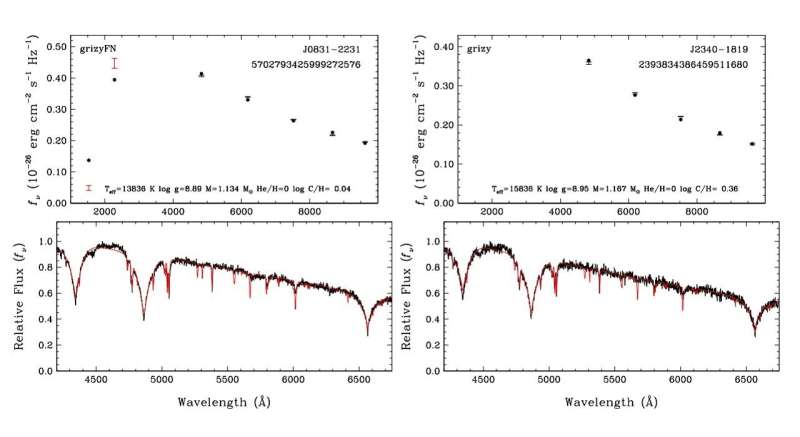March 21, 2024 report
This article has been reviewed according to Science X's editorial process and policies. Editors have highlighted the following attributes while ensuring the content's credibility:
fact-checked
preprint
trusted source
proofread
Four new DAQ white dwarfs discovered

Astronomers from the University of Oklahoma and their colleagues report the detection of four white dwarf stars of a recently discovered rare DAQ spectral subclass. The newfound white dwarfs are slightly more massive than the sun. The finding was detailed in a research paper published March 13 on the preprint server arXiv.
The first DAQ white dwarf was discovered in 2020, and received the designation J055134.612+413531.09, or J0551+4135 for short. The researchers that detected J0551+4135 found that its spectrum is qualitatively similar to a typical hydrogen-atmosphere white dwarf, but with the addition of numerous absorption lines from atomic carbon. Thus, they classified this object as a first example of a new DAQ spectral subclass, which can be distinguished by a unique hydrogen/carbon mixed atmosphere.
In this latest study, the team of astronomers led by University of Oklahoma's Mukremin Kilic has conducted a study of the physical properties of nearby massive white dwarfs. By performing spectroscopic observations of some candidate white dwarfs, they found that four of them are of DAQ subclass.
"Through follow-up spectroscopy of massive white dwarf candidates within 100 pc, we identified two new DAQ white dwarfs with mixed carbon and hydrogen atmospheres. In addition, based on a detailed model atmosphere analysis, we demonstrated that two additional DAQ white dwarfs were overlooked in the literature," the researchers wrote in the paper.
The new DAQ white dwarfs are designated J0205+2057, J0831−2231, J0958+5853 and J2340−1819. They have masses within the range of 1.13–1.19 solar masses, while their effective temperatures were found to be between 13,836 and 16,871 K. The cooling age of these white dwarfs was estimated to oscillate around 1 billion years.
Therefore, the list of known DAQ white dwarfs now contains five objects. Four of them are located nearby, within only 330 light years away from the Earth.
According to the study, the galactic space velocities of the four white dwarfs suggest the Milky Way's thick disk or halo origin. Moreover, rapid rotation was detected in at least two of these objects. These properties make them similar to warm white dwarfs of spectral type DQ—those with carbon absorption features in their spectra.
Based on the collected data and the similarities between DAQ and warm DQ white dwarfs, the astronomers assume that the DAQ population are white dwarf merger remnants. In particular, these objects likely emerge as massive DA white dwarfs, produced in white dwarf mergers.
"Further theoretical studies of the spectral evolution of merger products, including hot and warm DQs and the DAQs would be beneficial for understanding the emergence of the DAQ subclass," the researchers concluded.
More information: Mukremin Kilic et al, White Dwarf Merger Remnants: The DAQ Subclass, arXiv (2024). DOI: 10.48550/arxiv.2403.08878
Journal information: arXiv
© 2024 Science X Network





















